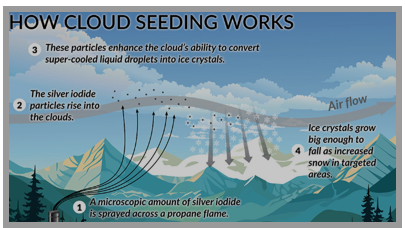Syllabus:
GS-3: Conservation, environmental pollution and degradation, environmental impact assessment
Context: Recently, the Delhi government and IIT-Kanpur conducted two cloud-seeding trials to induce artificial rain under a signed Memorandum of Understanding.
More on the News
- A Cessna 206H aircraft took off from the IIT-Kanpur airstrip and entered Delhi’s airspace from the Meerut airfield, conducted a cloud seeding trial in Delhi amid the recent spike in air pollution.
- Flares weighing about 0.5 kg, and burning for 2 to 2.5 minutes, released silver iodide and sodium chloride into moisture-bearing clouds.
- No rain was recorded in Delhi after the trials but according to government officials, the AQI, PM2.5 and PM10, the most direct pollution markers, saw a dip at locations like Mayur Vihar and Burari.
Cloud Seeding
- The Indian Institute of Tropical Meteorology (IITM), Pune, defined cloud seeding as a technique “used to modify suitable clouds with ‘seed’ particles to increase rainfall.”
• Mechanism:

- The process works by dispersing seed particles called Cloud condensation nuclei (CCN), often silver iodide, through flights into moisture-containing clouds to provide surfaces around which water vapor can condense.
- These particles have a molecular structure similar to ice crystals, which encourages supercooled water droplets in the cloud to freeze and form ice crystals.
- As ice crystals grow larger by collecting moisture, they eventually become heavy enough to fall as precipitation rain or snow thereby increasing natural rainfall.
• Types of Seeding:
- Glaciogenic seeding: It uses ice nuclei like silver iodide to induce freezing in supercooled clouds.
- Hygroscopic seeding: It uses salts to accelerate the coalescence of water droplets in warmer clouds.
Meteorological requirements for Cloud Seeding
• Sufficient moisture: The target clouds must contain an adequate amount of water vapour and liquid water to be condensed into precipitation.
• Cloud characteristics: Clouds targeted for seeding must have sufficient vertical thickness.
- For cold cloud seeding, the cloud must contain “supercooled” liquid water (water in liquid state despite below freezing point). The cloud must be at least −20°C to −7°C.
- For warm cloud seeding, the cloud temperature must be above freezing.
• Favourable winds: Wind speed must not be so high that it prevents clouds from growing tall or blows the seeding agents away from the target zone.
• Vertical air currents: Clouds with strong vertical updrafts are considered ideal because they help disperse the seeding agents and promote cloud development.
Applications of Cloud Seeding
- Agriculture: It is used to induce artificial rain and provide relief in drought-prone or arid areas, enhancing crop yields and ensuring food security.
- Water Resource Management: It augments freshwater availability by increasing rainfall and snowfall, refilling reservoirs and aquifers.
- Air Pollution Control: It facilitates settling of toxic air pollutants by inducing rain that washes pollutants out of the atmosphere.
- Fog Dispersion: It improves visibility and navigation around airports, roads, and industrial areas by clearing fog.
- Snowpack Enhancement: It increases mountain snowpack for improved spring runoff, critical for water security in regions and snowfall-driven Tourism prospects.
Limitations of cloud seeding
- Temporary solution: It does not offer a permanent solution for problems like air pollution, as pollution levels can quickly rebound.
- Environmental risks: The use of chemical agents can potentially contaminate soil and water bodies and impact biodiversity.
- Limited efficacy: It cannot induce rainfall in the absence of suitable clouds or sufficient moisture.
- Ethical and legal concerns: The manipulation of weather systems and the potential impact on rainfall patterns in neighbouring regions.
- Not Targeting Core issues: Focusing on cloud seeding as a pollution-control strategy may distract from essential, long-term reforms in air-quality management and sustainable urban planning.

